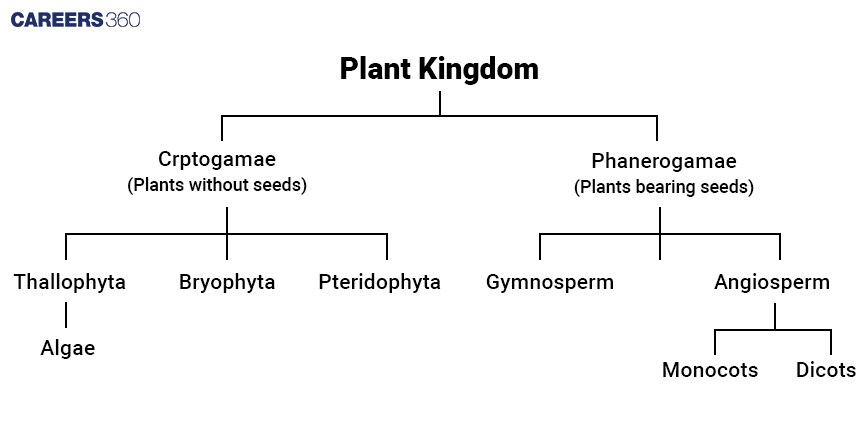What is Taxonomy: Definition, Examples, Levels, & Classification
What Is Taxonomy?
Taxonomy is the science of classification and naming of living organisms. It is an effort to put the species into a tree-like or hierarchical view of their relations and characteristics that are evolutionary.
Taxonomy, as a branch of biology, constitutes a very critical area as it provides a language in common that scientists use to communicate on species, be useful in carrying out identification as well as studies on some biodiversity, and also help in the appreciation of the different evolutionary relationships existing amidst different organisms.
Don't Miss: Most scoring concepts for NEET | NEET papers with solutions
NEET 2025: Syllabus | PYQs | Crack NEET in 2 months - Study Plan
NEET Important PYQ & Solutions: Physics | Chemistry | Biology | NEET PYQ's (2015-24)
- What Is Taxonomy?
- Linnaeus Classification System
- Basics of Taxonomy
- Criteria for Classification
- Major Classification Systems
- Plant Taxonomy
- Animal Taxonomy
- Tools and Techniques in Taxonomy
- Importance of Taxonomy in Various Fields
- Recommended video on Taxonomy and Systematics

Linnaeus Classification System
Modern taxonomy was established by Carolus Linnaeus in the 18th century. He proposed the system of binomial nomenclature under which every species would be identified with a two-part Latin name and developed a classification that was hierarchical or layered. Most of it is still used until today. The huge variation in forms of life on Earth could be classified because of the work carried out by Linnaeus.
Basics of Taxonomy
Explanation of Classification Systems:
Hierarchical Classification
This type of classification system categorises a living organism based on its similarities and common ancestors. The different levels of classification are:
Domain: The highest rank groups organisms based on the most general, basic differences in cell structure. There are three domains: Archaea, Bacteria, and Eukarya.
Kingdom: Divides domains into large groups like Animalia-animals; Plantae-plants; Fungi; Protista; and Monera-prokaryotes.
Phylum: Groups organisms in a kingdom according to their major body plans or structures.
Class: Divides phyla into groups with more specific characteristics.
Order: Divide classes into groups with more specific similarities.
Family: Divides orders into groupings of genera that are closely similar.
Genus: species that are very similar and considered to have shared a recent ancestor.
Species: This is the most specific referring to every organism that could be bred or crossed with one another and they would yield fertile offspring.
Binomial Nomenclature
Binomial nomenclature is the method of giving names to species and consists of two words in Latin. The first one is the genus name, and it starts with a capital letter, while the second part is the species locator, starting with a small letter. In the species Homo sapiens, the Homo represents the genus part and the sapiens represents the species.
Criteria for Classification
Morphology
This form of classification groups organisms according to the form and structure of the organism. This can range from size, shape, and other physical attributes. These are all basically the main features that people look for in the first place when trying to discern one species from another.
Anatomy
Anatomical classification is based on the study of internal structures and organ systems of living things. For example number of bones, muscle systems, organ arrangement, etc. Therefore, more detailed information can be accessed when cross-referencing different species.
Genetic Information
Recent advances in molecular biology have made genetic information the most important criterion for classification. That is, a comparison of the DNA sequences ultimately reveals the evolutionary relationships. So scientists can alter the organisms according to their genetic similarities and differences with each other.
Evolutionary Relationships
Phylogenetics is the study of evolutionary relationships among organisms. Scientists employ both morphological and genetic data. These trees diagram the evolutionary pathways and connections between different species that visually demonstrate their common ancestry and divergence.
Major Classification Systems
These classification systems frame the immense diversity of life forms on Earth and indicate their evolutionary relationships and ecological roles.
Three-Domain System
Carl Woese proposed the three-domain system that separates life into three large domains. It is based on major differences in the sequence of the highly conserved molecule ribosomal RNA as well as the cell's structural features.
Archaea
Archaea are single-celled microorganisms of the Domain Archaea. They live in extreme environments like hot springs, salt lakes, and deep-sea hydrothermal vents. The membrane lipids and their distinctive genetic sequences separate them from both bacteria and eukaryotes. Examples include the Methanogens that produce methane gas.
Bacteria
Unicellular bacteria are unlike the archaea in terms of cell membrane composition and rRNA sequences. They are very diverse and are found virtually in every ecological niche on Earth. They carry out such important functions as decomposition, nitrogen fixation, and disease causation as pathogens. A bacterial species example is Escherichia coli, a common gut bacterium, and Streptococcus, a pathogen.
Eukarya
It includes all organisms whose cellular structure consists of eukaryotic cells. Having a true nucleus and membrane-bound organelles, eukaryotes exclude all microbes of the previous domains at a stroke and range from single-celled protists to complex multicellular life forms like plants, animals, or fungi.
Five-Kingdom System
The five-kingdom system by Robert Whittaker offered a means to classify life into five unique kingdoms according to cell organisation and nutritional methods.
Monera
This domain includes all prokaryotic forms, those that lack a clearly defined nucleus, and other membrane-bound organelles. Monera is thought to be an old term; it is replaced by domains Archaea and Bacteria. Cyanobacteria Photosynthetic bacteria Spirochetes.
Protista
Protists are a catch-all eukaryotic kingdom, meaning that they are an unmatched group of mostly unicellular organisms that do not fit nicely into the other eukaryotic kingdoms. They are mostly autotrophic but there are some heterotrophic species Some can move using pseudopodia Amoeba, flagella, or cilia Paramecium.
Fungi
Fungi are mostly multicellular organisms. obtain their nutrition by absorption They are extremely important as decomposers, they decompose organic matter and recycle the nutrients. Mushrooms Yeasts Molds.
Plantae
This is the kingdom of all multicellular photosynthetic organisms. Plants have cellulose cell walls and photosynthesise using chlorophyll. Examples: Mosses, Ferns, Flowering Plants.
Animalia
Plants are multicellular, photosynthetic organisms with cellulose cell walls. They photosynthesis using chlorophyll. Examples: Mosses, Ferns, Flowering Plants.
Plant Taxonomy
The Kingdom Plantae includes all eukaryotic chlorophyll-containing organisms having prominent chloroplasts and cellulosic cell walls.
The mode of nutrition is mainly autotrophic. It occurs through the process of photosynthesis.
However, some plants have heterotrophic modes of nutrition, such as Cuscuta which is a parasitic plant. Insectivorous plants like Venus Fly Trap are partially heterotrophic.
The reserve food material is starch.
Ecologically, they act as producers in an ecosystem.
All plants are divided into two broad groups i.e. cryptogams and Phanerogamae
Cryptogams include all plants that do not form seeds while phanerogams include plants with seeds.
Cryptogamae includes Thallophyta, Bryophyta and Pteridophyta while Phanerogamae includes gymnosperms and angiosperms.
An outline of plant classification is as follows:

Animal Taxonomy
Animals are eukaryotic and multicellular organisms.
An animal cell lacks a cell wall.
The plasma membrane forms the outermost layer of the cell.
They obtain their food in the form of organic carbon from plants or other animals, so animals are called heterotrophic.
They are also called consumers.
They can be herbivores (feeding on plants and plant parts), parasites (feeding on a host organism by killing or weakening it), carnivores (feeding on the flesh of other animals), and omnivores (feeding on both plants and flesh).
Animal Kingdom is divided into the following Phyla
Porifera
Coelenterata
Ctenophora
Platyhelminthes
Aschelminthes (Nemathelminthes)
Annelids
Arthropoda
Mollusca
Echinodermata
Hemichordata
Chordata
Different Phyla are divided based on the following characters
Levels of Organization
Body Symmetry
Germ Layers
Coelom
Segmentation
Notochord
Tools and Techniques in Taxonomy
The tools plus techniques applied in taxonomy refer to a set of methods through which organisms are classified and identified. Morphological tools apply various physical traits of organisms, including size, shape, and structure, and this has been the traditional approach in taxonomy. Molecular applications have given taxonomy a very exact form of genetic information. DNA barcoding employs a short sequence of genetic material from a standardised region of an organism's genome to assign a specimen to a described species.
Importance of Taxonomy in Various Fields
It is a discipline with diverse applications. In medicine, it will help in identifying and classifying pathogens, which will lead to the diagnosis and appropriate treatment of certain diseases. In agriculture, it ensures that crops are suitably identified, as well as pests, which helps in the management of the crop and food security. In ecology, taxonomy facilitates the ease of studying biodiversity and the interaction of species within the ecosystem. In environmental conservation, it aids in the identification of endangered species for targeted conservation efforts in sustaining biodiversity.
Recommended video on Taxonomy and Systematics
Conclusion
Taxonomy is the science of classifying and naming organisms that dates back to a time when only morphological tools were available. A reliable taxonomy is essential in medicine, agriculture, ecology, and conservation for a systematic way of recognising biodiversity. In days to come, taxonomic methods will get more refinement by genetic research and bioinformatics, which will hold the key to classifying and preserving the diversity of life on Earth.
Frequently Asked Questions (FAQs)
The branch of biology which is involved in the classification and naming of living organisms remains taxonomy. It grouped related species into large hierarchical rankings of groups, based on relatedness or ancestry among other common characteristics.
Binomial nomenclature assigns to each species a two-part Latin name: the first part is the genus and the second that which picks out the species, eg: Homo sapiens.
The major classification systems are the three-domain system (Archaea, Bacteria, Eukarya) and the five-kingdom system (Monera, Protista, Fungi, Plantae, Animalia).
Taxonomy puts many different organisms in a context where their names and classifications can readily be understood and related to other organisms. The science of classifying living things is important for understanding the context of biodiversity, evolutionary relationships, and the ecological roles of organisms in the environment.
Modern taxonomy uses morphological tools to analyse physical traits and molecular tools like DNA barcoding, phylogenetics, and genomics to study genetic relationships. Bioinformatics is also crucial for managing and interpreting complex biological data.
Also Read
26 Nov'24 12:47 PM
25 Nov'24 04:42 PM
25 Nov'24 02:53 PM
09 Nov'24 01:16 PM
09 Nov'24 09:27 AM
18 Sep'24 07:02 PM
18 Sep'24 02:03 PM
12 Aug'24 04:14 PM